

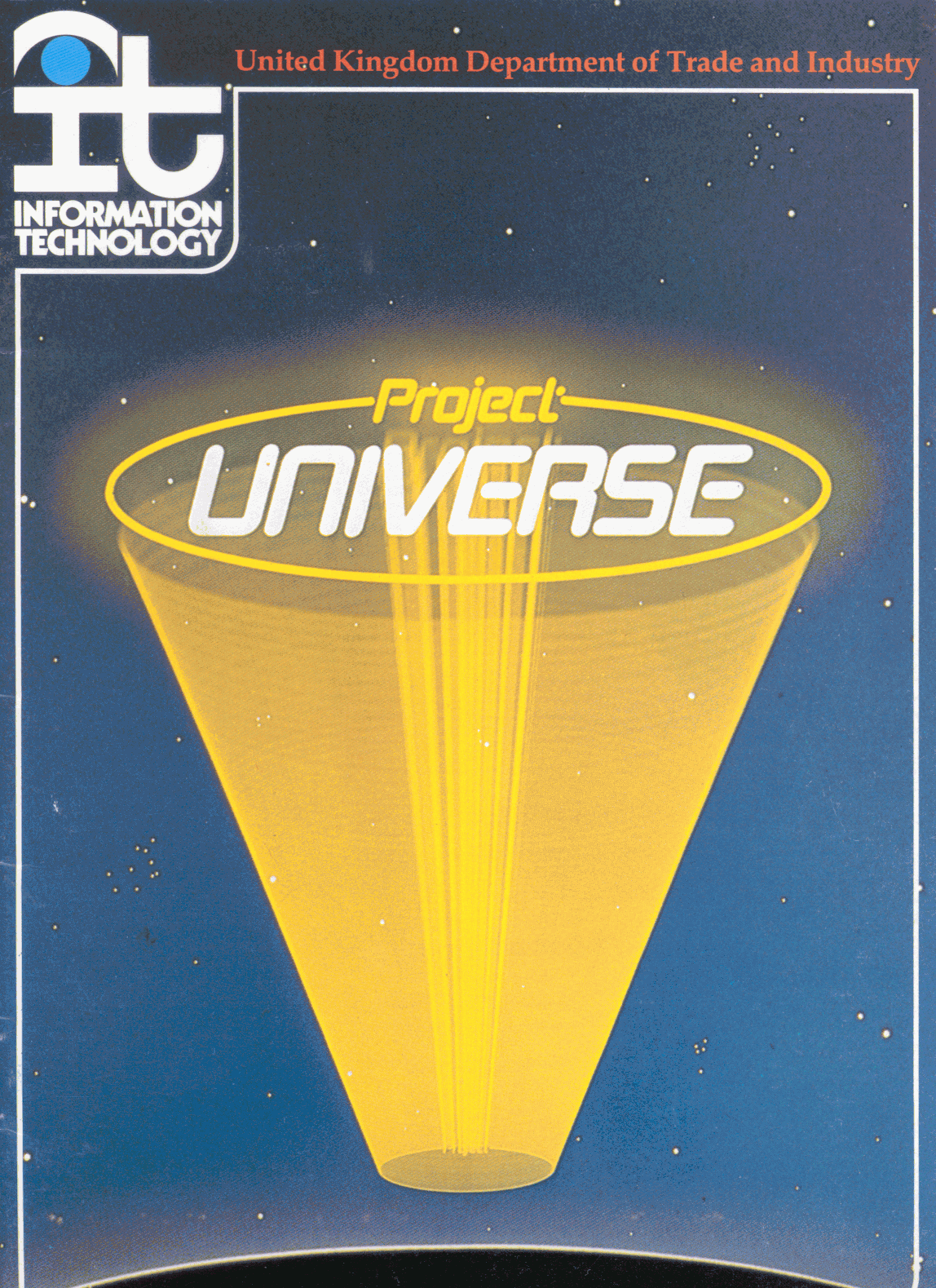
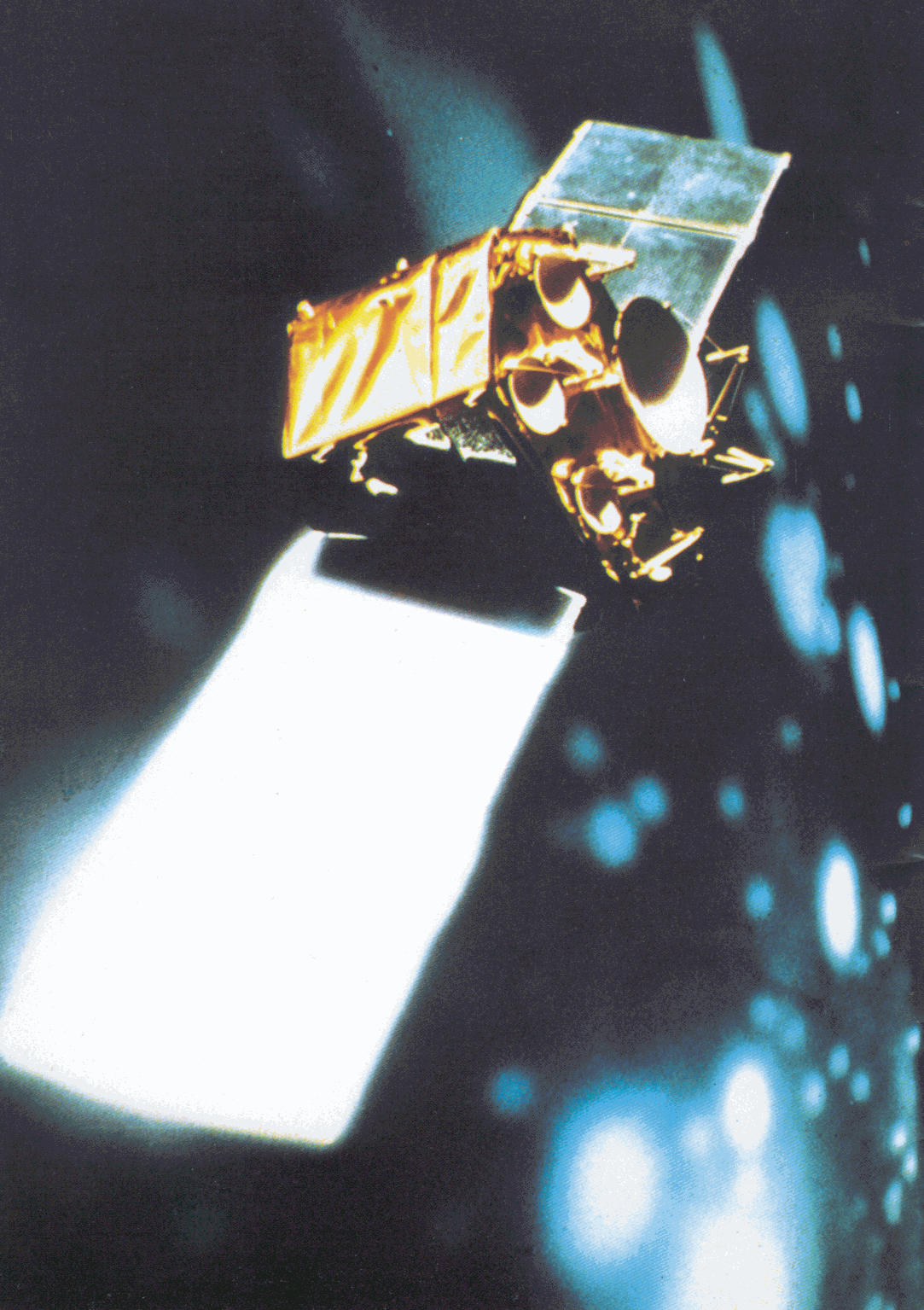
Project UNIVERSE is an advanced experiment linking local area networks by satellite so that a computer in Geneva, say, can interact with one in London as though they were in the same room.
The high-bandwidth network enables new techniques in computer science to be researched for the first time.
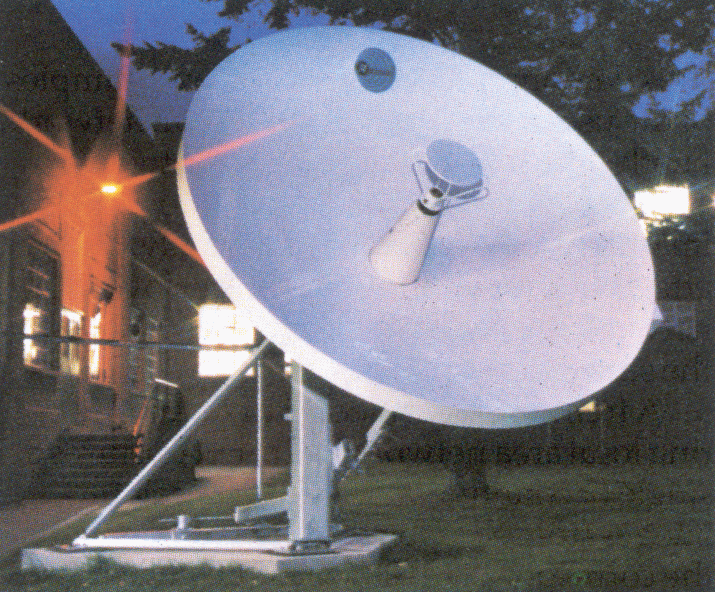
Project UNIVERSE is a natural extension to STELLA - the satellite transmission experiment linking laboratories - in which CERN in Geneva played an important role. Named from the Universities Expanded Ring and Satellite Experiment, Project UNIVERSE has been set up by the British Government, universities and industry. Cambridge rings and other types of local area network at six sites in the United Kingdom are linked via the European Space Agency's Orbital Test Satellite- in geostationary orbit 36,000km above the equator. The earth stations comprise a 3m diameter dish aerial, 14 GHz radio transmitter and 11 GHz receiver, and the network links.
The six United Kingdom sites are at Cambridge University, Loughborough University of Technology, University College London, the Marconi Research Centre, the British Telecom Research Laboratory, and the Rutherford Appleton Laboratory of the Science and Engineering Research Council. During the exhibition, an earth station at Geneva will provide a seventh site - allowing 1 Megabit per second communication with any of the UK sites.
Brief details of the projects demonstrated at Telecom 83 are given on the following pages.
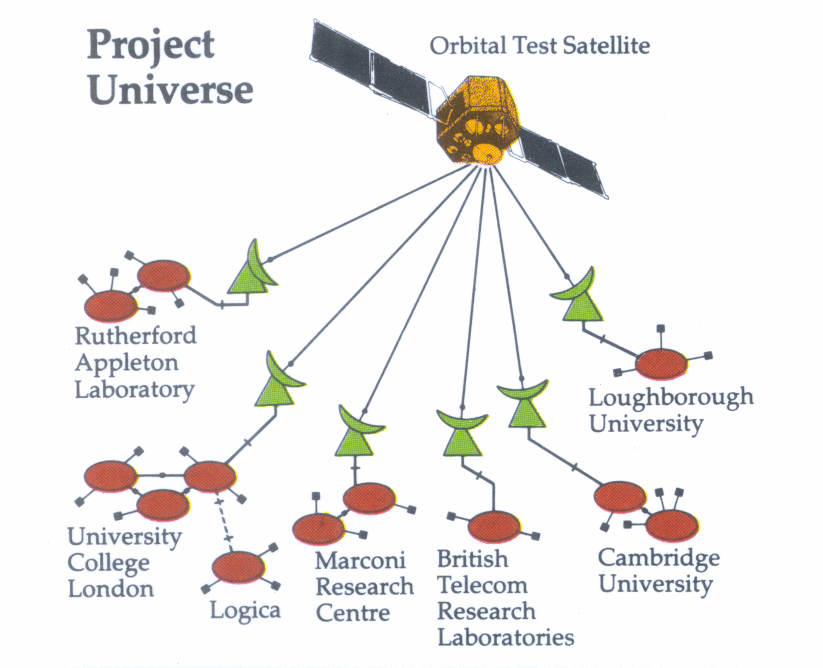
British Telecom Research Laboratories (BTRL) are interested in the transmission of videotex information over the Project UNIVERSE network.
The main database is held on a GEC series 4000 computer residing on the BTRL local area network at Martlesham Heath, Ipswich. The database holds summary information about each participant's work within Project UNIVERSE. Both standard Prestel and full-screen Picture Prestel frame formats are used. A back-up database is installed on the exhibition ring using a microcomputer with twin floppy disk storage.
Information is accessed using a high-speed photovideotex terminal. Alternatively, ordinary text frames may be displayed using a low cost microcomputer programmed to act as a Prestel terminal.
On requesting the videotex service via the local name server, the client is prompted for his user identity and password. If this is valid, he will be connected to the database and presented with a WELCOME page. Information may then be accessed using the simple commands familiar to the Prestel user:
The remote access of information from other Project UNIVERSE sites is seen as the first phase in providing a videotex service with a geographically distributed database.

This demonstration embodies two examples of the use of the Project UNIVERSE network. Firstly, the high data rate of the network is exploited to transfer slow scan colour TV images from a remote site. Secondly, the effective error-free transfer of data over the network enables reliable control of robots at the same remote site.
A framestore connected to a Cambridge ring local area network in the UK captures a single or continuous sequence of colour images from a camera input, and transmits the corresponding data over the Project UNIVERSE network at 240 kbits/second. The receiving frames tore in Geneva displays the image on a conventional colour monitor as it arrives. Either the whole frame or a smaller user-selected area can be transferred from one framestore to another. Such selection enables more rapid updating of the main area of interest when transferring a continuous sequence of images. The remaining area can be updated less frequently.
At the remote sites, two types of robot are interfaced to microcomputers on the local area network. One robot is used to position the TV camera while the other is in the form of an articulated arm fitted with a moveable clamp.
To provide user control of the slow scan image transfer and of the robots, a microcomputer receives typed instructions and forwards these in a suitable form to the local framestore or remote robot as required.
During TELECOM 83, two framestores will be in operation at the Geneva site while two more framestores and several robots will be located in the United Kingdom at the Rutherford Appleton Laboratory and at Loughborough University of Technology.
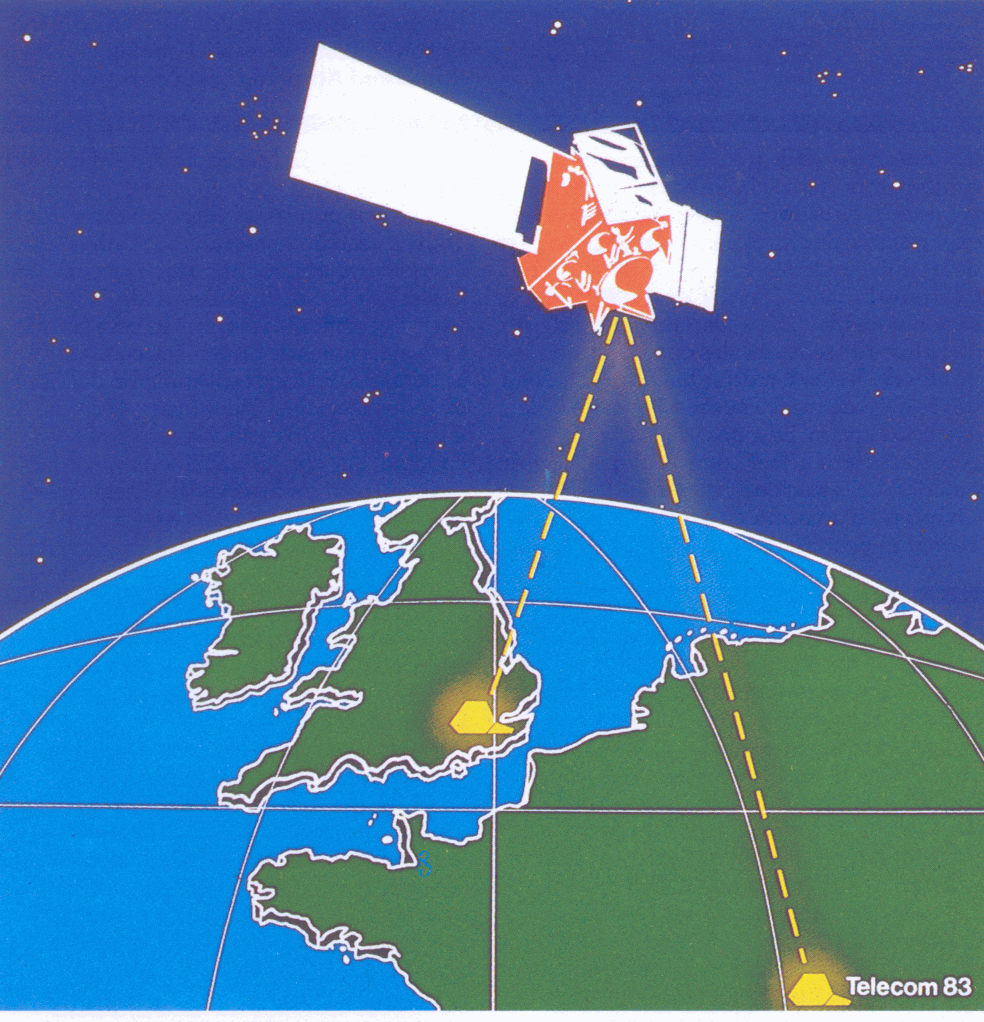
The ability to retrieve and display information in pictorial form is of fundamental importance in the field of Information Technology. The demonstration shows how the Project UNIVERSE network may be used by a simple workstation to access several small picture databases situated in a variety of locations.
A widely available, low-cost personal microcomputer is used to retrieve and display colour pictures from picture stores situated elsewhere on the network. The pictures are composed of text, bit-mapped images, graphics orders, or a combination of these. The maximum amount of data in a picture is about 16 kilobytes, equivalent to about four A4 pages of text. The time taken to connect to the remote picture store, retrieve and display the picture is a few seconds. Pictures may be retrieved quickly and easily from anywhere within range of the satellite. The effective range of OTS is the whole of Western Europe.
Several picture stores are available on the network, An Acorn 68000-based system with a 10 megabyte Winchester disc is attached to the exhibition ring and provides a service when the satellite is not available. At Rutherford Appleton Laboratory, three more picture stores are available - on a GEC 4090 computer, an Acorn 68000 system, and an Intel 8086 system.
The demonstration illustrates a very simple use of the Project UNIVERSE network. The user of the terminal may select the name of the picture to be displayed and then name the picture store from which to retrieve it. The program in the microcomputer requests the local name lookup service to translate the name of the picture store to a network address, and then sends a request for the pictures to this address. The picture store responds with an acknowledgement and a sequence of data blocks containing the picture.

Remote access to a database held on a computer has been a familiar idea for many years now. Information workers in the UK regularly interrogate bibliographic databases held on computers in the USA or Europe. Full text retrieval is also becoming commonplace.
University College London has for some time been looking at ways of extending this to include a much greater variety of information types. Stored speech or sound, for instance, might be included within the data, as could graphics and facsimile images. Such multimedia documents require very high data rates for their effective transmission: a page of text or videotex can be encoded in, say, 1000 bytes, but it could take 1000 times that to encode a page of facsimile data into digital form, with a corresponding increase in transmission time.
Communication over the conventional telephone network runs at only about 150 bytes (or characters) per second. But on a local area network (LAN) very high data rates of hundreds of thousands of bytes per second are possible. This means that the transmission of large text files or of digitally encoded facsimile images around such a network can be accomplished very quickly. The limitation with conventional LANs, however, is that they are confined to a relatively small area - within a single building, for example, or just one city block.
The Project UNIVERSE network provides a way of extending the LAN concept to cover any geographical area. If local area networks are linked by a satellite, then data may be transferred between two LANs (even if they are on different continents) at almost the same rate as within a single LAN. Large and complex files can be transmitted between any two global points at great speed with relative ease.
To demonstrate this idea at Telecom 83, UCL is showing the retrieval of multimedia documents from databases in the UK via the OTS satellite. Small files of text, graphics and bit-map frames have been stored on fileservers at both UCL and RAL in the form of simple multimedia documents. These files can be interrogated from Geneva and the requested documents displayed.
Finally, although the underlying hardware necessary to support a high-performance satellite network such as Project UNIVERSE may be relatively complex and expensive, the same need not be true of the means of access. Simple low-cost terminals can provide a very effective interface to the network. For this reason we have chosen an Acorn microcomputer as a general purpose display terminal, and our demonstration is intended to show how such a device may provide access to data files held on a remote site of the extended ring network.
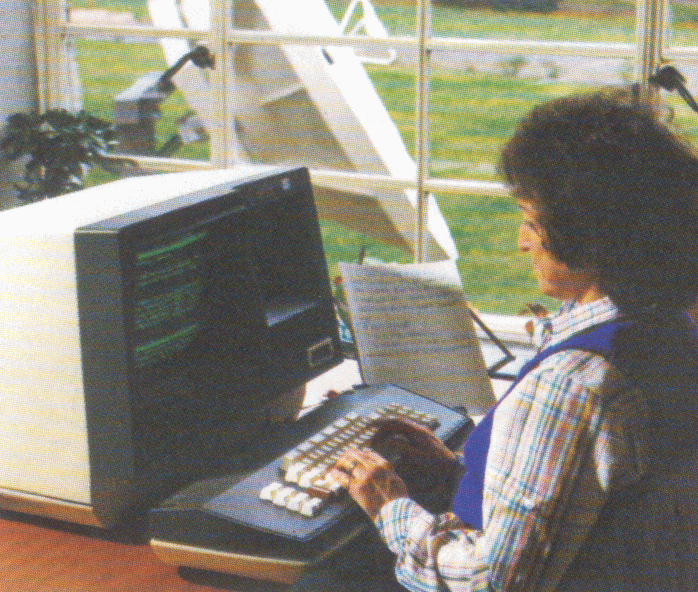
The integration of voice, images and data will radically change the nature of future communications networks. The Project UNIVERSE network has been designed to explore these problems and to provide simple demonstrations of services based on such a network. This demonstration shows a simple voice messaging system, which will allow people to both record and playback voice messages. Other experiments on voice include real-time voice communication and the development of speech compression techniques.
The telephones are connected to a Cambridge ring using a simple and cheap interface based on a 280 microprocessor. A specially designed board deals with the conversion of analogue speech into digital form using 64 kilobytes per second pulse code modulation encoding. It also handles the telephone dialling conventions. Telephone conversations can be made between telephones or, as in this case, to the recorded voice service. The voice server has a file store which can hold up to 30 minutes of speech split into a large number of individual messages. The voice server is situated at the Rutherford Appleton Laboratory and is based on a GEC4090 computer. It runs as an ordinary applications program and uses standard data management techniques to store the speech on disk. Although there is currently only one voice server, the program is easily portable and it has been run as a distributed service using two sites.
The user dials the number of the person to whom he wishes to send a recorded message, preceded by a 0. Dialling his own number preceded by a 2 will playback those messages which have recently been sent to him. The system is also linked to the electronic mail system and a mail shot is sent to the recipient whenever a voice message is recorded. This message allows the user to playback individual messages at any time.
Project UNIVERSE is a consortium of:
BBC microcomputers have been supplied by Acorn Computers, earth stations by British Telecom International (and built by Marconi Communications Systems), disc drives by Cumana, link driving computers by GEC Computers, colour monitors by GEC McMichael, ring equipment by Logica VTS and Seel, and cameras by Marconi Avionics. Other UK manufacturers have supplied various items and components.